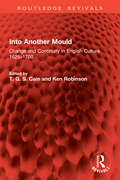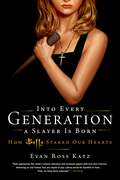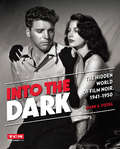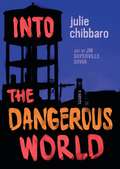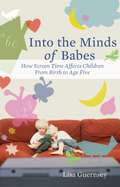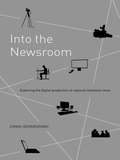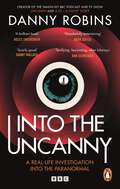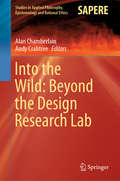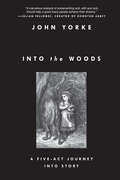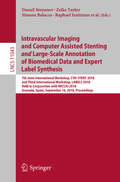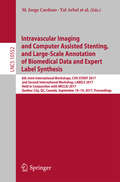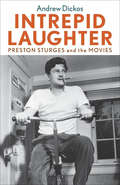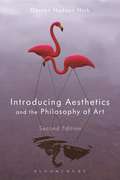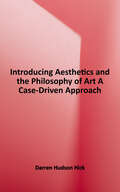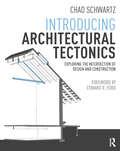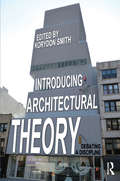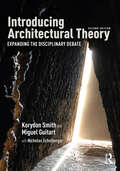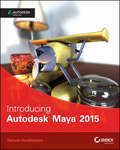- Table View
- List View
Into Another Mould: Change and Continuity in English Culture 1625–1700 (Routledge Revivals)
by Ken Robinson T.G.S. CainIt is widely agreed that the period from 1625 to 1700 witnessed radical shifts in English life and thought. For historians of politics, science, religion, and philosophy, it is a time when the intellectual bases of modern thought and modern institutions were in the process of formation: divine monarchy gave way to contractual monarchy, the ‘truths’ of received authority gave way to those reached by inductive reasoning.Although the year 1660 to some extent marks a turning point, this comprehensive and fascinating book, Into Another Mould (originally published in 1992), demonstrates an underlying continuity within the period of Stuart rule. It presents thinkers and writers before and after 1660 responding to similar dilemmas, albeit with different attitudes, methods, and conclusions.Central to this volume are the related concepts of authority and reason. By looking at the changing attitudes to these two concepts in all spheres of life, it examines the crucial developments of the period and their bearing on the literature. Within this framework, the authors examine social and political history, religious belief and scientific knowledge, and painting, sculpture, and architecture as contexts for the literature of the time. This book will be a beneficial read for students and researchers of English literature, history, and cultural studies.
Into Every Generation a Slayer Is Born: How Buffy Staked Our Hearts
by Evan Ross KatzExplore the history and cultural impact of a groundbreaking television show adored by old and new fans alike: Buffy the Vampire Slayer. Over the course of its seven-year run, Buffy the Vampire Slayer cultivated a loyal fandom and featured a strong, complex female lead, at a time when such a character was a rarity. Evan Ross Katz explores the show&’s cultural relevance through a book that is part oral history, part celebration, and part memoir of a personal fandom that has universal resonance still, decades later.Katz—with the help of the show&’s cast, creators, and crew—reveals that although Buffy contributed to important conversations about gender, sexuality, and feminism, it was not free of internal strife, controversy, and shortcomings. Men—both on screen and off—would taint the show&’s reputation as a feminist masterpiece, and changing networks, amongst other factors, would drastically alter the show&’s tone.Katz addresses these issues and more, including interviews with stars Sarah Michelle Gellar, Charisma Carpenter, Emma Caulfield, Amber Benson, James Marsters, Anthony Stewart Head, Seth Green, Marc Blucas, Nicholas Brendon, Danny Strong, Tom Lenk, Bianca Lawson, Julie Benz, Clare Kramer, K. Todd Freeman, Sharon Ferguson; and writers Douglas Petrie, Jane Espenson, and Drew Z. Greenberg; as well as conversations with Buffy fanatics and friends of the cast including Stacey Abrams, Cynthia Erivo, Lee Pace, Claire Saffitz, Tavi Gevinson, and Selma Blair.Into Every Generation a Slayer Is Born engages with the very notion of fandom, and the ways a show like Buffy can influence not only how we see the world but how we exist within it.
Into The Dark: The Hidden World Of Film Noir, 1941-1950 (Turner Classic Movies)
by Mark A. VieiraThe cinematic art of film noir--the dark, fascinating American movie genre that started 75 years ago, was rediscovered in the ’70s, and has a worldwide cult following today--is showcased in Into the Dark. You know film noir when you see it: the shadowed setting; the world-weary detective; the damsel in distress; and the twist of fate. Into the Dark captures this alluring genre with a cavalcade of compelling photographs and a guide to its best films. Author Mark A. Vieira takes readers on a year-by-year tour of the film factories that made these movies, profiling the artists who worked on them, and explaining how they accomplished their moody lighting effects. Into the Dark also tells the story of film noir with quotes from the filmmakers and vintage reviews, taking readers to the exciting nights when Murder My Sweet, Out of the Past, and The Big Heat were sprung on an unsuspecting public.
Into the Dangerous World
by Julie Chibbaro Jean-Marc Superville SovakAt a family meeting, Ror declares her purpose: I am an artist.But she doesn't really know what that means. Raised on a commune, she's never attended a day of school, and has seen little of the outside world. What she knows best is drawing. To her, it's like breathing; it's how she makes sense of the world. When her father torches the commune--and himself--Ror's life changes. She, her mother and sister end up in a homeless residence in Manhattan, where she runs into trouble--and love--with Trey, the leader of Noise Ink, a graffiti crew. On the city's streets, and in its museums and galleries, Ror finds herself pulled in different directions. Her father wanted her to make classic art. Noise Ink insists she stay within their lines. Her art teacher urges her to go to college. What does she want? What kind of artist am I? Ror's journey is a seamless blend of words and pictures, cinematic in its scope--a sharp-edged, indelible work of art that will live inside your head.From the Hardcover edition.
Into the Fire: The Fight to Save Fort McMurray
by Graham Hurley Jerron Hawley Steve SackettThe dramatic story of one of the biggest natural disasters in Canadian history, the Fort McMurray wildfire of 2016, told by three of the firefighters who fought to save the city. On May 1, 2016, a wildfire burning to the southwest of Fort McMurray, Alberta, led to the declaration of a local state of emergency. Two days later, the fire had reached Fort McMurray, forcing the evacuation of 88,000 citizens and destroying 2,400 buildings. In total, the fire would consume more than 500,000 hectares. Into the Fire is a remarkable first-hand account of fighting a major wildfire as it moved with terrifying speed. Over the course of six days, firefighters Jerron Hawley, Graham Hurley, and Steve Sackett of the Fort McMurray Fire Department joined local expert wildfire teams and fire departments from across the country to battle the blaze. In photographs and notes made at the time, they vividly describe what they witnessed; their own personal losses and triumphs; and the fire's devastating effects. With more than 90 stunning colour photographs, Into the Fire is a dramatic eyewitness account of one of the most catastrophic disasters in recent North American history. Intimate in its telling, it is above all a testament to the courage, pride, and extraordinary efforts of the citizens of Fort McMurray, who along with emergency personnel, came together to save their city.
Into the Great White Sands
by Craig VarjabedianPhotographic masterpiece on beloved White Sands National Park; now in paperback. Winner of the New Mexico-Arizona Book Award for Photography. Like Ansel Adams in a contemporary and pristine setting. Powerfully relevant today.Award-winning photographer Craig Varjabedian has spent decades photographing the many moods of the magnificent and ever-changing landscape of New Mexico&’s White Sands National Monument. His photographs reveal snow-white dunes of gypsum, striking landforms, storms and stillness, panoramic vistas and breathtaking sunsets, intricate wind-blown patterns in the sand, ancient animal tracks, exquisite desert plants, and also the people who come to experience this place that is at once spectacular yet subtle. Varjabedian&’s evocative color images provide the reader with an almost palpable sense of this extraordinary place.These photographs are enriched by several essays written by Jeanetta Calhoun Mish, noted poet and author; Dennis Ditmanson, retired White Sands National Monument superintendent; Jim Eckles, retired Missile Range public affairs officer; and Craig Varjabedian, the photographer who shares his insights and experiences of photographing this inspiring landscape and offers tips on making better pictures of White Sands.
Into the Minds of Babes: How Screen Time Affects Children from Birth to Age Five
by Lisa GuernseyAs a mother, Lisa Guernsey wondered about the influence of television on her two young daughters. As a reporter, she resolved to find out. What she first encountered was tired advice, sensationalized research claims, and a rather draconian mandate from the American Academy of Pediatrics: no TV at all before the age of two. But like many parents, she wanted straight answers and realistic advice, so she kept digging: she visited infant-perception labs and child development centers around the country. She interviewed scores of parents, psychologists, cognitive scientists, and media researchers, as well as programming executives at Noggin, Disney, Nickelodeon, Sesame Workshop, and PBS. Much of what she found flies in the face of conventional wisdom and led her to conclude that new parents will be best served by focusing on “the three C’s”: content, context, and the individual child. Advocating a new approach to television and DVDs, Guernsey focuses on infants to five-year-olds and goes beyond the headlines to explore what exactly is “educational” about educational media. She examines how play and language development are affected by background and foreground television and how to choose videos that are age-appropriate. She explains how to avoid the hype of “brain stimulation” and focus instead on social relationships and the building blocks of language and literacy. Along the way, Guernsey highlights independent research on shows ranging from Dora the Explorer to Dragon Tales, and distills some surprising new findings in the field of child development. Into the Minds of Babesis a fascinating book that points out how little credible research exists to support the AAP’s dire recommendation. Parents, teachers, and psychologists will be relieved to learn positive approaches to using videos with young children and will be empowered to make their own informed choices.
Into the Newsroom: Exploring the Digital Production of Regional Television News
by Emma HemmingwayInto the Newsroom provides a rigorous investigation into the everyday rituals that are performed in the television newsroom, and offers a unique suggestion that news is both a highly haphazard and yet technologically complicated process of deliberate construction involving the interweaving of reflexive professional journalists as well as developing, unpredictable technologies. Arguing specifically for a recognition and an exploration of technological agency, this book takes the reader on an exciting journey into the digital newsroom, using exclusive observation and interviews from those journalists working on the BBC's recent pilot project of local television news as part of its empirical evidence. This is an essential introduction for both those seeking to understand news processes at the level of every day routines and practices, and for those students and scholars who are eager to adopt new and challenging ways to theorise news as practice.
Into the Past
by William BeardGuy Maddin started making films in his back yard and on his kitchen table. Now his unique work, which relies heavily on such archaic means as black and white small-format cinematography and silent-film storytelling, premieres at major film festivals around the world and is avidly discussed in the critical press. Into the Past provides a complete and systematic critical commentary on each of Maddin's feature films and shorts, from his 1986 debut film The Dead Father through to his highly successful 2008 full-length 'docu-fantasia' My Winnipeg.William Beard's extensive analysis of Maddin's narrative and aesthetic strategies, themes, influences, and underlying issues also examines the origins and production history of each film. Each of Maddin's projects and collaborations showcase his gradual evolution as a filmmaker and his singular development of narrative forms. Beard's close readings of these films illuminate, among other things, the profound ways in which Maddin's art is founded in the past - both in the cultural past, and in his personal memory.
Into the Uncanny
by Danny Robins'A wonderfully entertaining ride' - Mark Gatiss, co-creator of Sherlock'A brilliant book, engaging and filmic' - Reece Shearsmith, co-creator of Inside No. 9'Scarily good!' - Danny Wallace, author of Yes Man‘The ghosts of today don’t live in castles or stately homes, they’re in normal houses and workplaces, witnessed by people just like you and me. But are they the dead returning from the “undiscovered country” of death, or the product of that equally mysterious location, the human mind?’Danny Robins is on a mission to try to solve the greatest of all mysteries – do ghosts exist? This thrilling book tells the stories of ordinary people who have experienced extraordinary things and want to understand them. It is also a journey of self-discovery, as Danny explores what the paranormal means to us, and considers the exciting yet terrifying prospect that we are not alone.From poltergeists and apparitions, to UFOs and strange messages from beyond the grave, Into the Uncanny is a page-turning real-life supernatural adventure. So, are you Team Believer or Team Sceptic – and do you dare to find out?With a new and exclusive bonus chapter containing case updates
Into the Vortex: Female Voice and Paradox in Film
by Britta H. SjogrenInto the Vortex challenges and rethinks feminist film theory's brilliant but often pessimistic reflections on the workings of sound and voice in film. Including close readings of major film theorists such as Kaja Silverman and Mary Ann Doane, Britta H. Sjogren offers an alternative to image-centered scenarios that dominate feminist film theory's critique of the representation of sexual difference. Sjogren focuses on a rash of 1940s Hollywood films in which the female voice bears a marked formal presence to demonstrate the ways that the feminine is expressed and difference is sustained. She argues that these films capitalize on particular particular psychoanalytic, narratological and discursive contradictions to bring out and express difference, rather than to contain or close it down. Exploring the vigorous dynamic engendered by contradiction and paradox, Sjogren charts a way out of the pessimistic, monolithic view of patriarchy and cinema's representation of women's voices.
Into the Wild: Beyond the Design Research Lab (Studies in Applied Philosophy, Epistemology and Rational Ethics #48)
by Andy Crabtree Alan ChamberlainThis edited collection opens up new intellectual territories and articulates the ways in which academics are theorising and practicing new forms of research in ‘wild’ contexts. Many researchers are choosing to leave the familiarity of their laboratory-based settings in order to pursue in-situ studies ‘in the wild’ that can help them to better understand the implications of their work in real-world settings. This has naturally led to ethical, philosophical and practical reappraisals with regard to the taken for granted lab-based modus operandi of scientific, cultural and design-based ways of working. This evolving movement has led to a series of critical debates opening up around the nature of research in the wild, but up until now these debates have not been drawn together in a coherent way that could be useful in an academic context. The book brings together applied, methodological and theoretical perspectives relating to this subject area, and provides a platform and a source of reference material for researchers, students and academics to base their work on. Cutting across multiple disciplines relating to philosophy, sociology, ethnography, design, human–computer interaction, science, history and critical theory, this timely collection appeals to a broad range of academics in varying fields of research.
Into the Woods: A Five-Act Journey Into Story
by John YorkeAn analysis of the fundamental narrative structure, why it works, the meanings of stories, and why we tell them in the first place.The idea of Into the Woods is not to supplant works by Aristotle, Lajos Egri, Robert McKee, David Mamet, or any other writers of guides for screenwriters and playwrights, but to pick up on their cues and take the reader on a historical, philosophical, scientific, and psychological journey to the heart of all storytelling. In this exciting and wholly original book, John Yorke not only shows that there is truly a unifying shape to narrative—one that echoes the great fairytale journey into the woods, and one, like any great art, that comes from deep within—he explains why, too. With examples ranging from The Godfather to True Detective, Mad Men to Macbeth, and fairy tales to Forbrydelsen (The Killing), Yorke utilizes Shakespearean five-act structure as a key to analyzing all storytelling in all narrative forms, from film and television to theatre and novel-writing—a big step from the usual three-act approach. Into the Woods: A Five-Act Journey into Story is destined to sit alongside David Mamet’s Three Uses of the Knife, Robert McKee’s Story, Syd Field’s Screenplay, and Lajos Egri’s The Art of Dramatic Writing as one of the most original, useful, and inspiring books ever on dramatic writing.Praise for Into the Woods“Love storytelling? You need this inspiring book. John Yorke dissects the structure of stories with a joyous enthusiasm allied to precise, encyclopedic knowledge. Guaranteed to send you back to your writing desk with newfound excitement and drive.” —Chris Chibnall, creator/writer, Broadchurch and Gracepoint“Outrageously good and by far and away the best book of its kind I’ve ever read. I recognized so much truth in it. But more than that, I learned a great deal. Time and again, Yorke articulates things I’ve always felt but have never been able to describe. . . . This is a love story to story—erudite, witty and full of practical magic. I struggle to think of the writer who wouldn’t benefit from reading it—even if they don’t notice because they’re too busy enjoying every page.” —Neil Cross, creator/writer, Luther and Crossbones“Part ‘how-to’ manual, part ‘why-to’ celebration, Into the Woods is a wide-reaching and infectiously passionate exploration of storytelling in all its guises . . . exciting and thought-provoking.” —Emma Frost, screenwriter, The White Queen and Shameless
Intravascular Imaging and Computer Assisted Stenting and Large-Scale Annotation of Biomedical Data and Expert Label Synthesis: 7th Joint International Workshop, CVII-STENT 2018 and Third International Workshop, LABELS 2018, Held in Conjunction with MICCAI 2018, Granada, Spain, September 16, 2018, Proceedings (Lecture Notes in Computer Science #11043)
by Emanuele Trucco Eric Granger Pierre Jannin Su-Lin Lee Diana Mateus Lena Maier-Hein Veronika Cheplygina Simone Balocco Guillaume Zahnd Stefanie Demirci Luc Duong Shadi Albarqouni Danail Stoyanov Zeike Taylor Anne Martel Raphael Sznitman Stefano MoriconiThis book constitutes the refereed joint proceedings of the 7th Joint International Workshop on Computing and Visualization for Intravascular Imaging and Computer Assisted Stenting, CVII-STENT 2018, and the Third International Workshop on Large-Scale Annotation of Biomedical Data and Expert Label Synthesis, LABELS 2018, held in conjunction with the 21th International Conference on Medical Imaging and Computer-Assisted Intervention, MICCAI 2018, in Granada, Spain, in September 2018. The 9 full papers presented at CVII-STENT 2017 and the 12 full papers presented at LABELS 2017 were carefully reviewed and selected. The CVII-STENT papers feature the state of the art in imaging, treatment, and computer-assisted intervention in the field of endovascular interventions. The LABELS papers present a variety of approaches for dealing with few labels, from transfer learning to crowdsourcing.
Intravascular Imaging and Computer Assisted Stenting, and Large-Scale Annotation of Biomedical Data and Expert Label Synthesis
by Eric Granger Su-Lin Lee M. Jorge Cardoso Gustavo Carneiro Diana Mateus Tal Arbel Lena Maier-Hein Veronika Cheplygina Simone Balocco Guillaume Zahnd Stefanie Demirci Luc Duong Marc-André Carbonneau Shadi AlbarqouniThis book constitutes the refereed joint proceedings of the 6th Joint International Workshop on Computing and Visualization for Intravascular Imaging and Computer Assisted Stenting, CVII-STENT 2017, and the Second International Workshop on Large-Scale Annotation of Biomedical Data and Expert Label Synthesis, LABELS 2017, held in conjunction with the 20th International Conference on Medical Imaging and Computer-Assisted Intervention, MICCAI 2017, in Québec City, QC, Canada, in September 2017. The 6 full papers presented at CVII-STENT 2017 and the 11 full papers presented at LABELS 2017 were carefully reviewed and selected. The CVII-STENT papers feature the state of the art in imaging, treatment, and computer-assisted intervention in the field of endovascular interventions. The LABELS papers present a variety of approaches for dealing with few labels, from transfer learning to crowdsourcing.
Intrepid Laughter: Preston Sturges and the Movies (Screen Classics)
by Andrew DickosThe life and career of the pioneering writer-director whose name is synonymous with sophisticated screwball comedies.Preston Sturges was known for bringing sophistication and wit to the genre of comedy, establishing himself as one of the most valuable writer-directors in 1940s Hollywood. Today, more than a half century after they were originally produced, his films have lost little of their edge and remain extremely popular.Intrepid Laughter is an essential guide to the life and work of this luminary of the stage and screen, following Sturges from his unusual childhood, to his early success as a Broadway playwright, to his whirlwind career in Hollywood.
Introducing Aesthetics and the Philosophy of Art (2nd Edition)
by Darren Hudson Hick<p><i>Introducing Aesthetics and the Philosophy of Art</i> is written to introduce students to a broad array of questions that have occupied philosophers since antiquity, and which continue to bother us today-questions like: <p> <li>Is there something special about something's being art? Can a mass-produced plastic bird have that special something? <li>If someone likes plastic pink flamingos, does that mean they have bad taste? Is bad taste a bad thing? <li>Do Featherstone's pink flamingos mean anything? If so, does that depend on what Featherstone meant in designing them?</li> <p> <p>Each chapter opens using a real world example - such as Marcel Duchamp's signed urinal, The Exorcist, and the ugliest animal in the world - to introduce and illustrate the issues under discussion. These case studies serve as touchstones throughout the chapter, keeping the concepts grounded and relatable. <p>With its trademark conversational style, clear explanations, and wealth of supporting features, Introducing Aesthetics and the Philosophy of Art is the ideal introduction to the major problems, issues, and debates in the field. Now expanded and revised for its second edition, <i>Introducing Aesthetics and the Philosophy of Art</i> is designed to give readers the background and the tools necessary to begin asking and answering the most intriguing questions about art and beauty, even when those questions are about pink plastic flamingos.</p>
Introducing Aesthetics and the Philosophy of Art: A Case-Driven Approach, Third Edition
by Darren Hudson HickAesthetics and the philosophy of art are about things in the world – things like the Mona Lisa, but also things like horror movies, things like the ugliest dog in the world, and things like wallpaper. There’s a surprising amount of philosophical content to be found in wallpaper. Using a case-driven approach, Introducing Aesthetics and the Philosophy of Art is grounded in real-world examples that propel thought, debate, and discussion about the nature of art and beauty. Now in its third edition, this tried-and-tested text features fresh cases and new activities. Hands-on Do Aesthetics! activities pepper the text, and Challenge Cases appear at the end of each chapter to test intuitions, complicate the field of discussion, and set a path forward. Charlotte Perkins Gilman’s “The Yellow Wall-Paper” serves as a recurring case throughout, and this edition includes the full text of this classic short story. From classical debates that continue to bother philosophers today, to emerging problems of identity, appropriation, and morality, this introduction is designed to engage you in a field that itself engages with so much of the world around you. Here is everything you need to know about the history, themes, thinkers, and theories to get you started on aesthetics and the philosophy of art.
Introducing Architectural Tectonics: Exploring the Intersection of Design and Construction
by Chad SchwartzIntroducing Architectural Tectonics is an exploration of the poetics of construction. Tectonic theory is an integrative philosophy examining the relationships formed between design, construction, and space while creating or experiencing a work of architecture. In this text, author Chad Schwartz presents an introductory investigation into tectonic theory, subdividing it into distinct concepts in order to make it accessible to beginning and advanced students alike. The book centers on the tectonic analysis of twenty contemporary works of architecture located in eleven countries including Germany, Italy, United States, Chile, Japan, Bangladesh, Spain, and Australia and designed by such notable architects as Tadao Ando, Herzog & de Meuron, Kengo Kuma, Olson Kundig, and Peter Zumthor. Although similarities do exist between the projects, their distinctly different characteristics – location and climate, context, size, program, construction methods – and range of interpretations of tectonic expression provide the most significant lessons of the book, helping you to understand tectonic theory. Written in clear, accessible language, these investigations examine the poetic creation of architecture, showing you lessons and concepts that you can integrate into your own work, whether studying in a university classroom or practicing in a professional office.
Introducing Architectural Theory: Debating a Discipline
by Korydon SmithThis is the most accessible architectural theory book that exists. Korydon Smith presents each common architectural subject – such as tectonics, use, and site – as though it were a conversation across history between theorists by providing you with the original text, a reflective text, and a philosophical text. He also introduces each chapter by highlighting key ideas and asking you a set of reflective questions so that you can hone your own theory, which is essential to both your success in the studio and your adaptability in the profession. These primary source texts, which are central to your understanding of the discipline, were written by such architects as Le Corbusier, Robert Venturi, and Adrian Forty. The appendices also have guides to aid your reading comprehension; to help you write descriptively, analytically, and disputationally; and to show you citation styles and how to do library-based research. More than any other architectural theory book about the great thinkers, Introducing Architectural Theory teaches you to think as well.
Introducing Architectural Theory: Expanding the Disciplinary Debate
by Korydon Smith Miguel GuitartBuilding on the success of the first edition, an engaging and reader-friendly work on complex ideas, Introducing Architectural Theory: Expanding the Disciplinary Debate, broadens the range of themes, voices, and geographies represented to provide a more comprehensive and contemporary theory book. This book presents major discourses in architectural theory and design in a debate-like format, integrating a series of edited texts across architectural history with context and newly written commentaries by the authors. This new edition has been fully revised, updated, and expanded to include long-standing debates, such as simplicity vs. complexity or the relationship between form and function, as well as newer discussions on innovation, globalization, and social equity. Authors Smith and Guitart provide a comprehensive means and conceptual framework for readers to compare multiple points of view. The chapter structure, discussion questions, and additional resources allow teachers to facilitate in-class discussions and writing assignments. This book remains the most accessible architectural theory textbook, written for beginning architecture students and those outside the discipline. Its reflective and critical approach will equally engage the minds of upper-level students and experts.
Introducing Art
by Rosalind Ragans Gene Mittler Jean Morman Unsworth Faye ScannellThe book presents, with a thematic focus, a wide range of artworks and styles and groups them by the themes that served as inspiration for the works--people, places, animals and nature. Animals and stick people appeared on the walls of caves more than twelve thousand years ago which today as a visual link to our forebears. Celebrations and events are commemorated in paintings, sculpture, and photographs. These and other themes in Introducing Art will bring creative inspiration to the classroom.
Introducing Autodesk 3ds Max 2011
by Dariush DerakhshaniAn Autodesk Official Training Guide to 3ds Max 2011 3ds Max is a popular 3D animation-and-effects software used in movies, visual effects, games, cartoons, short films, commercials, and other animation. However, it also presents a number of challenges to newcomers. This introduction to the latest version breaks down the complexities of learning 3D software and walks you through the basics of modeling, texturing, animating, and using visual effects. Real-world examples from talented beginning 3ds max users motivate you to learn the software and helpful tutorials offer realistic, professional challenges for you to unravel. In addition, each chapter is richly illustrated with workflows to make learning 3ds max 2011 much easier and fn. Introduces you to the basics of modeling, texturing, animating, and incorporating visual effects using the latest version of 3ds Max software Features excellent tutorials, helpful examples, detailed workflows, and a companion Web site to enhance your learning experience Explains a variety of methods for solving real-world challenges and breaks down why certain methods are used Makes the transition of coming from other 3D software applications as smooth as possible Introducing 3ds Max 2011 takes a typically difficult subject and breaks into easily digestible pieces so you can confidently begin working with this 3D animation software today.
Introducing Autodesk Maya 2015
by Dariush DerakhshaniLearn Autodesk Maya from an award-winning insider <P><P> Best-selling author, visual effects supervisor, and technical educator Dariush Derakhshani brings you a newly-updated, step-by-step guide to the most popular and complex 3D application on the market, Autodesk Maya. Introducing Autodesk Maya 2015 includes straightforward lessons, real-world examples, detailed tutorials, and downloadable project files that get you modeling and animating your own digital models and scenes right away.<P> The book starts you with the latest CG concepts and production workflows, and then shows you how to create a solar system to help get you acquainted with the basic tool set in Maya. From there, the books helps you: <P> * Learn the Maya user interface, including menus and plug-ins <P> * Build simple animations and 3D images right away <P> * Explore polygons, modeling, and NEX tools<P> * Get started with HDRI lighting, rendering, dynamics, simulations, and effects <P> Whether you're new to 3D or migrating from another 3D application, Introducing Autodesk Maya 2015 will kick-start your creativity and get you up and running with Maya. Author Derakhshani has worked on movies such as The Fantastic Four and Pan's Labyrinth, the South Park TV series, and numerous commercials and music videos.
Introducing Autodesk Maya 2016: Autodesk Official Press
by Dariush DerakhshaniStart modeling right away with this hands-on guide to learning Autodesk Maya 2016 Introducing Autodesk Maya 2016 is the official guide to the most popular and complex 3D application on the market. Building from the ground up, this book combines straightforward text with practical examples that make it easy to absorb the basics and start designing and animating your own digital models and scenes. The tutorials offer realistic challenges and clear explanations, laid out in fun, step-by-step lessons that help you gain confidence and learn by doing. You'll delve into CG and 3D core concepts and production workflows, then get right to work designing an animation of the solar system as you learn the interface and basic tools. As your modeling skills grow, you'll build a steam locomotive, a starfish, a table lamp, and much more as you learn to rig your model for animation, create fabric motion with nCloth, and add the lighting and effects that bring your scenes to life. The companion website features downloadable project files that help you see how the pros do it, and the book includes real-world examples from talented users who were beginners just like you. Master the Maya 2016 interface, menus, and plug-ins Begin building simple animations right away Explore modeling, rendering, animation, and cloth motion Add lighting, rendering, dynamics, simulations, and effects If you want to work like the pros, Introducing Autodesk Maya 2016 is the perfect primer for getting started.
